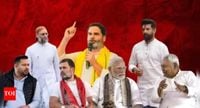Voters in Bihar, one of India’s most politically charged states, headed to the polls on November 6, 2025, in the first phase of a closely watched state election that many see as a crucial test for Prime Minister Narendra Modi’s leadership and his ruling alliance’s grip on power. With more than 37.5 million eligible voters casting ballots across 121 constituencies in 18 districts, the election—conducted in two phases—will determine the makeup of Bihar’s 243-seat legislature and could ripple far beyond state borders.
The stakes are high. Bihar, with its 130 million residents and its status as an agrarian powerhouse, has long been a bellwether in Indian politics. The results, expected on November 14, will signal whether Modi’s Bharatiya Janata Party (BJP)-led National Democratic Alliance (NDA) can maintain its dominance or faces growing discontent over issues like unemployment, law and order, and allegations of voter disenfranchisement.
According to AP, the election is taking place amid widespread public concerns. Unemployment rates remain stubbornly high, law and order issues persist, and a recent revision of electoral rolls has sparked controversy. Nearly 10% of Bihar’s 74 million registered voters were removed from the rolls since June, which opposition parties argue disproportionately affects poor and minority communities. The Election Commission, however, maintains that the revision was necessary due to large-scale migration, new young voters, and unreported deaths.
“Bihar’s election is not just about alliances but arithmetic,” New Delhi-based analyst Sidharth Mishra told AP. “If the NDA led by Modi falters, it could unsettle his coalition at the center.”
Modi’s party, which failed to win a majority in last year’s federal vote, is heavily reliant on its Bihar partners: Chief Minister Nitish Kumar’s Janata Dal (United) and the Lok Janshakti Party (Ramvilas). Nitish Kumar, now 74, has governed Bihar for nearly two decades and is widely credited with improving infrastructure and restoring order to a state once synonymous with political violence. Once an opponent of Modi, Kumar later rejoined the NDA, making the alliance’s fate deeply intertwined with his own.
The opposition is not sitting idle. The Rashtriya Janata Dal (RJD), led by Tejashwi Prasad Yadav, has joined forces with Congress and other smaller parties to form the Mahagathbandhan, or Grand Alliance. A new player, Jan Suraaj Party, led by Modi’s former poll strategist Prashant Kishor, is also making its debut, adding another layer of complexity to the contest.
Polling began early in the morning, with lines forming outside stations across the state. According to Times of India, voting hours stretched from 7 am to 6 pm, though in some constituencies, polling ended an hour earlier due to security concerns. The first phase alone covers more than half of Bihar’s districts, with 1.072 million new voters—including 778,000 in the 18–19 age group—adding fresh energy and unpredictability to the race.
Key constituencies have become battlegrounds for political heavyweights and rising stars alike. In Raghopur, Tejashwi Yadav is seeking a third term, facing off against BJP’s Satish Kumar Yadav, Prem Kumar from the Janshakti Janta Dal, and Chanchal Singh of the Jan Suraaj Party. Raghopur, a Yadav-dominated seat and a family bastion for Tejashwi, is emblematic of the election’s high stakes. Despite its prestige, the seat has struggled with development—its long-awaited all-weather link to Patna only opened this June with the inauguration of the six-lane Kacchi Dargah-Bidupur bridge by Chief Minister Kumar.
Other notable contests include Alinagar, where celebrity singer Maithili Thakur is making her political debut for the BJP, and Chhapra, where Bhojpuri film star Khesari Lal Yadav (Shatrughan Yadav) is running for the RJD, energizing the campaign trail with his star power. In Mokama, the murder of an RJD supporter and the subsequent arrest of JD(U) candidate and strongman Anant Singh has heightened tensions, underscoring the persistent law and order concerns that loom over the election.
Beyond personalities and alliances, the issues at play are deeply rooted. Bihar remains one of India’s poorest states, with a fragile economy that has struggled to create enough jobs for its growing population. To woo voters, both the NDA and its rivals have promised to create millions of government jobs—a pledge that many economists, including Pushpendra Kumar of the Tata Institute of Social Sciences, view with skepticism. “The state government has initiated welfare measures but has rarely attempted to address underlying causes of poverty such as landlessness, low wages and limited employment opportunities,” Kumar told AP.
Prime Minister Modi has sought to shore up support among women, a crucial voting bloc, by distributing cash transfers of 10,000 Indian rupees (about $113) each to 7.5 million women as part of an employment program in September. With many men migrating to larger cities for work, women’s votes have become increasingly influential in Bihar’s political calculus.
The election has not been without its share of drama and controversy. Rahul Gandhi, leader of the Congress Party, has sharply criticized the recent electoral roll revision, calling it politically motivated and an attempt to disenfranchise opposition supporters. Meanwhile, the Election Commission insists its actions were above board, citing the need to update records in a state where migration and demographic change are constant realities.
As the campaign has unfolded, familiar themes of caste, development, and identity have mixed with newer concerns about governance and economic opportunity. The presence of new parties and outsider candidates—like Prashant Kishor’s Jan Suraaj Party—has injected fresh uncertainty into a contest already brimming with intrigue.
For Modi and his NDA coalition, a strong showing in Bihar would provide much-needed momentum ahead of national elections in 2029 and key state polls in Uttar Pradesh, West Bengal, and Assam over the next two years. A setback, however, could embolden the opposition and even threaten the stability of the central government, given its reliance on Bihar’s lawmakers.
“This election could affect not just Bihar’s leadership but the stability of Modi’s government,” Ravi Ranjan, a political science professor in New Delhi, told AP.
As voters wait for the results, one thing is clear: Bihar’s decision will reverberate far beyond its borders, shaping the future of Indian politics in ways both immediate and profound.

